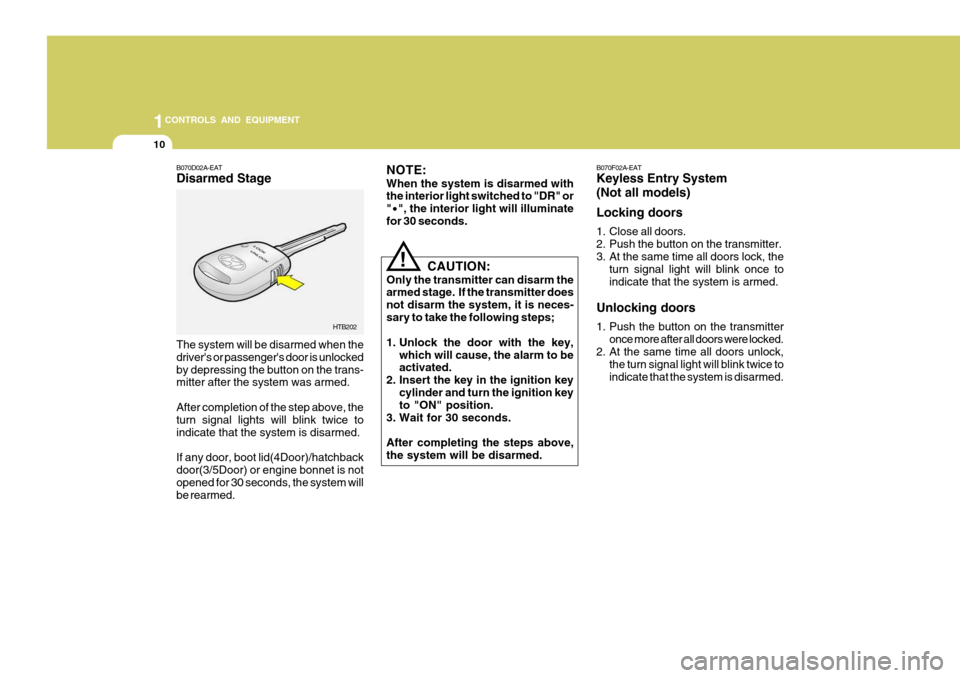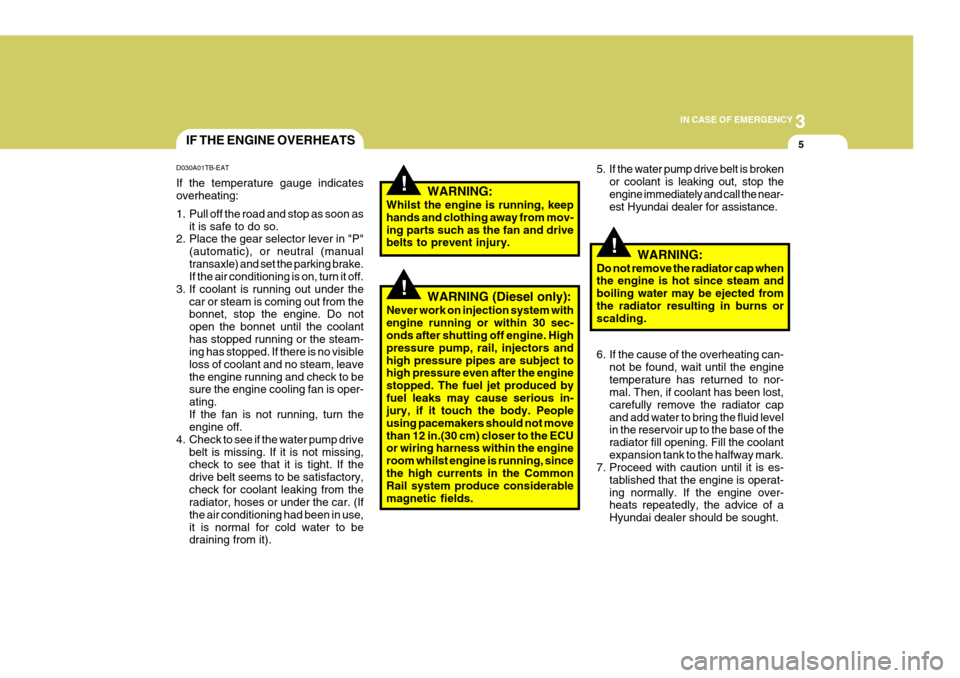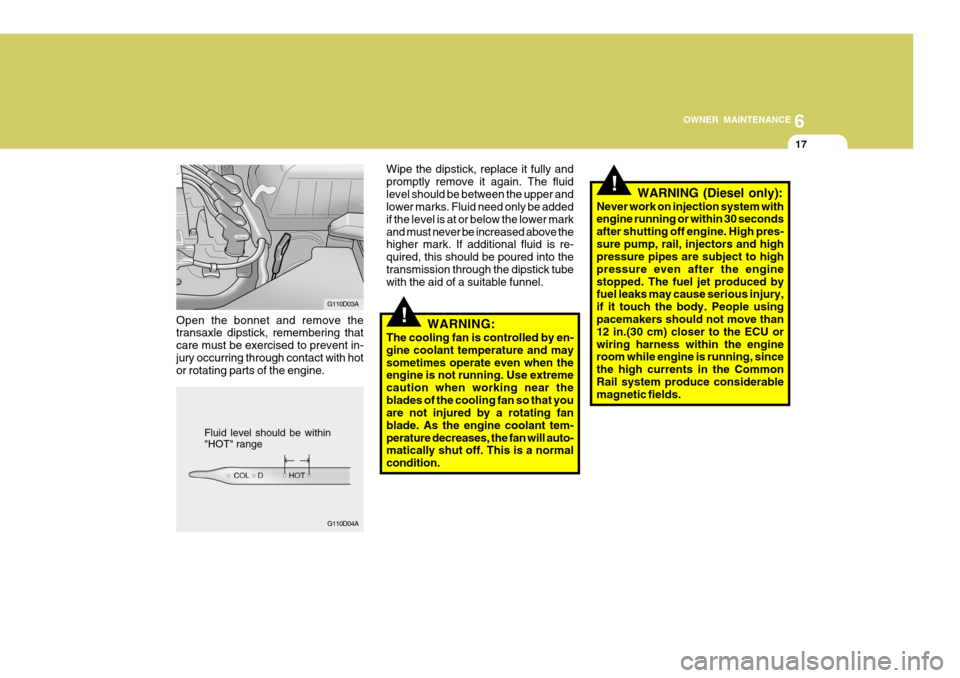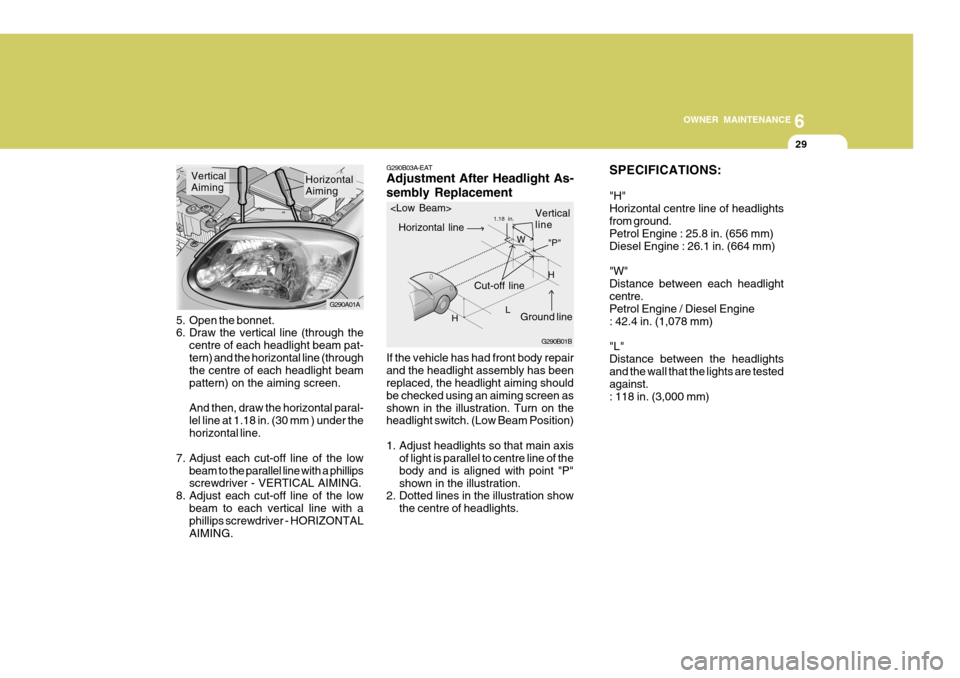bonnet Hyundai Accent 2006 Owner's Manual
[x] Cancel search | Manufacturer: HYUNDAI, Model Year: 2006, Model line: Accent, Model: Hyundai Accent 2006Pages: 599, PDF Size: 17.59 MB
Page 406 of 599

CAUTION:
When installing a container of liquid air freshener inside the vehicle, do not place it near the instrument cluster nor on the instrument panel pad surface. If there is any leakage from the air freshener onto these areas (Instrument cluster, instrument panel pad or air ventilator), it may damage these parts. If the liquid from air freshener does leak onto these areas, wash themwith water immediately.!
1. Passenger's Airbag (Not all models)
2. Glove Box
3. Heating/Air Conditioning Control Panel
(Not all models)
4. Rear Fog Light Switch
5. Rear Window Defogger Switch (Not all models)
6. Hazard Warning Light Switch
7. Front Fog Light Switch (Not all models)
8. Digital Clock 9. Windscreen Wiper/Washer Switch
10. Horn and Driver's Airbag
11. Instrument Cluster
12. Multi-Function Light Switch 13. Headlight Leveling Switch
14. Rear Wiper/Washer Switch (Not all models)
15. Rear Drink Holder
16. Parking Brake Lever
17. Shift Lever (Not all models)
18. Front Drink Holder
19. Ashtray
20. Cigar Lighter
21. Bonnet Release Lever
Page 408 of 599

Fuel Recommendations ................................................ 1-2
Running In Your New Hyundai ..................................... 1-4
Immobilizer System ...................................................... 1-5
Door .............................................................................. 1-6Power Windows........................................................... 1-11
Seat ............................... .............................................. 1-12
Seat Belt ...................................................................... 1-18
Child Restraint System ................................................ 1-22
Supplemental Restraint (AIRBAG) System .................1-31
Instrument Cluster and Indicator Lights .......................1-38
Warning and Indicator Lights....................................... 1-42
Trip Computer .............................................................. 1-48
Multi-Function Switch .................................................. 1-51
Windscreen Wiper/Washer Switch ..............................1-52
Sunroof ........................................................................ 1-59
Mirror ........................................................................... 1-64
Bonnet Release ........................................................... 1-67
Heating and Cooling Control .......... ..............................1-72
Stereo Sound System ................................................. 1-81
Antenna ....................................................................... 1-83
CONTROLS AND EQUIPMENT
1
1
Page 416 of 599

9
1
CONTROLS AND EQUIPMENT
CAUTION:
Do not arm the system until all pas- sengers have left the car. If the sys- tem is armed while a passenger(s) remains in the car, the alarm may beactivated when the remaining passenger(s) leaves the car.! B070C04A-EAT Alarm Stage The alarm will be activated if any of the following occurs while the car is parkedand the system is armed.
1) A door or hatchback door (3/5 Door)
is opened without using the trans- mitter.
2) The boot lid (4 Door) is opened with- out using the key.
3) The engine bonnet is opened. The alarming horn will sound and the turn signal light will blink continuously for 27 seconds. To turn off the system,unlock the door or hatchback door with the transmitter.
Park the car and stop the engine. Arm the system as described below.
1) Remove the ignition key from the
ignition switch.
2) Make sure that the engine bonnet and boot lid (4 Door)/hatchback door (3/5 Door) are closed.
3) Lock the doors using the transmitter of the keyless entry system.
After completion of the steps above, the turn signal lights will blink once to indicate that the system is armed. HLC2002-D
B070B02A-EAT Armed Stage
NOTE:
1) If any door, boot lid (4 Door)/hatch-
back door (3/5 Door) or engine bonnet remains open, the systemwill not be armed. If this happens, rearm the system as described above.
2) Once the system is armed, only the boot lid (4 Door) may be un-locked using the ignition key with-out disarming the system.
CAUTION:
Avoid trying to start the engine whilst the system is armed.
!
Page 417 of 599

1CONTROLS AND EQUIPMENT
10
B070D02A-EAT Disarmed Stage The system will be disarmed when the driver's or passenger's door is unlockedby depressing the button on the trans- mitter after the system was armed. After completion of the step above, the turn signal lights will blink twice to indicate that the system is disarmed. If any door, boot lid(4Door)/hatchback door(3/5Door) or engine bonnet is notopened for 30 seconds, the system will be rearmed. HTB202
CAUTION:
Only the transmitter can disarm thearmed stage. If the transmitter does not disarm the system, it is neces-sary to take the following steps;
1. Unlock the door with the key, which will cause, the alarm to be activated.
2. Insert the key in the ignition key
cylinder and turn the ignition keyto "ON" position.
3. Wait for 30 seconds. After completing the steps above, the system will be disarmed.
!
NOTE: When the system is disarmed with the interior light switched to "DR" or "
· ", the interior light will illuminate
for 30 seconds. B070F02A-EAT Keyless Entry System (Not all models) Locking doors
1. Close all doors.
2. Push the button on the transmitter.
3. At the same time all doors lock, the
turn signal light will blink once toindicate that the system is armed.
Unlocking doors
1. Push the button on the transmitter once more after all doors were locked.
2. At the same time all doors unlock,
the turn signal light will blink twice to indicate that the system is disarmed.
Page 474 of 599

67
1
CONTROLS AND EQUIPMENT
BONNET RELEASE
CAUTION:
Make sure that the support rod has been released prior to closing the bonnet.!
B570A03A-EAT
1. Pull the release knob to unlatch the
bonnet. HLC2017-D
B570A01A 2. Push the safety catch lever to the
left and lift the bonnet.
3. Hold the bonnet open with the sup- port rod.
Before closing the bonnet, return the support rod to its clip to prevent it from rattling. Lower the bonnet until it isabout 1 ft. (30 cm) above the closed position and let it drop. Make sure that it locks into place.
!WARNING:
o Always double check to be sure that the bonnet is firmly latched before driving away. If it is notlatched, the bonnet could fly open whilst the vehicle is being driven, causing a total loss of visibility,which might result in an accident.
o The support rod must be inserted
completely into the hole providedin the bonnet whenever you in- spect the engine compartment. This will prevent the bonnet fromfalling and possibly injuring you.
o Do not move the vehicle with the
bonnet in the raised position, asvision is obstructed and the bon- net could fall or be damaged.
Page 518 of 599

3
IN CASE OF EMERGENCY
5IF THE ENGINE OVERHEATS
!
!
D030A01TB-EAT If the temperature gauge indicates overheating:
1. Pull off the road and stop as soon as
it is safe to do so.
2. Place the gear selector lever in "P"
(automatic), or neutral (manual transaxle) and set the parking brake. If the air conditioning is on, turn it off.
3. If coolant is running out under the car or steam is coming out from thebonnet, stop the engine. Do not open the bonnet until the coolanthas stopped running or the steam- ing has stopped. If there is no visible loss of coolant and no steam, leavethe engine running and check to be sure the engine cooling fan is oper- ating.If the fan is not running, turn the engine off.
4. Check to see if the water pump drive belt is missing. If it is not missing,check to see that it is tight. If the drive belt seems to be satisfactory,check for coolant leaking from the radiator, hoses or under the car. (If the air conditioning had been in use,it is normal for cold water to be draining from it). WARNING:
Whilst the engine is running, keep hands and clothing away from mov-ing parts such as the fan and drive belts to prevent injury.
WARNING (Diesel only):
Never work on injection system with engine running or within 30 sec- onds after shutting off engine. High pressure pump, rail, injectors andhigh pressure pipes are subject to high pressure even after the engine stopped. The fuel jet produced byfuel leaks may cause serious in- jury, if it touch the body. People using pacemakers should not movethan 12 in.(30 cm) closer to the ECU or wiring harness within the engine room whilst engine is running, sincethe high currents in the Common Rail system produce considerable magnetic fields. 5. If the water pump drive belt is broken
or coolant is leaking out, stop theengine immediately and call the near- est Hyundai dealer for assistance.
!WARNING:
Do not remove the radiator cap when the engine is hot since steam and boiling water may be ejected fromthe radiator resulting in burns or scalding.
6. If the cause of the overheating can- not be found, wait until the engine temperature has returned to nor- mal. Then, if coolant has been lost, carefully remove the radiator capand add water to bring the fluid level in the reservoir up to the base of the radiator fill opening. Fill the coolantexpansion tank to the halfway mark.
7. Proceed with caution until it is es-
tablished that the engine is operat-ing normally. If the engine over- heats repeatedly, the advice of a Hyundai dealer should be sought.
Page 550 of 599

6OWNER MAINTENANCE
8
HTB222
Oil filler cap
Drain plug Oil filter
ENGINE OIL AND FILTER REPLACEMENT
o The engine oil consumption is strongly effected by the viscosity and quality of oil, engine rpm and driving condi- tion etc. More engine oil may be consumedunder severe driving conditions such as high speeds, frequent accelera- tion and deceleration, compared tonormal driving. G040A04A-EAT
The engine oil and filter must be changedat the time or mileage interval specifiedin the maintenance schedule. If the vehicle is operated under severe or adverse conditions, the oil and filtermust be replaced more frequently. To replace the oil and filter, proceed as follows:
1. Ensure that the engine is at normaloperating temperature and park the vehicle on level ground with the park- ing brake securely applied and the engine turned off.
2. Open the bonnet and remove the oil filler cap.
Petrol Engine (1.3/1.5 SOHC) Petrol Engine(1.6 DOHC)
Diesel Engine
F040A02TB
Oil filler cap Drain plug
Oil filter
.........
G040C01A-1Engine oil drain plug
Oil filter
Oil filler cap
Page 559 of 599

6
OWNER MAINTENANCE
17
!Open the bonnet and remove the transaxle dipstick, remembering that care must be exercised to prevent in-jury occurring through contact with hot or rotating parts of the engine. WARNING:
The cooling fan is controlled by en- gine coolant temperature and maysometimes operate even when the engine is not running. Use extreme caution when working near theblades of the cooling fan so that you are not injured by a rotating fan blade. As the engine coolant tem-perature decreases, the fan will auto- matically shut off. This is a normal condition.
Wipe the dipstick, replace it fully andpromptly remove it again. The fluidlevel should be between the upper and lower marks. Fluid need only be added if the level is at or below the lower markand must never be increased above the higher mark. If additional fluid is re- quired, this should be poured into thetransmission through the dipstick tube with the aid of a suitable funnel.
G110D03A
G110D04A
Fluid level should be within "HOT" range
!WARNING (Diesel only):
Never work on injection system with engine running or within 30 seconds after shutting off engine. High pres-sure pump, rail, injectors and high pressure pipes are subject to high pressure even after the enginestopped. The fuel jet produced by fuel leaks may cause serious injury, if it touch the body. People usingpacemakers should not move than 12 in.(30 cm) closer to the ECU or wiring harness within the engine room while engine is running, since the high currents in the CommonRail system produce considerable magnetic fields.
Page 561 of 599

6
OWNER MAINTENANCE
19CHECKING THE CLUTCH FLUID
!
SG130A1-C To Check the Clutch Fluid The clutch fluid level in the master cylinder should be checked when per-forming other under bonnet checks. The system should be checked for leakage at the same time.Ensure that the clutch fluid level is always between the "MAX" and "MIN" level markings on the fluid reservoir. Fillas required. Fluid loss indicates a leak in the clutch system which should be inspected and repaired immediately.
WARNING:
Brake fluid is hygroscopic andshould never be stored in an un- sealed container. The presence of water in the braking system will causevapour locks and increase the possi- bility of brake fade along with pro- moting corrosion within the brakingsystem. The brake fluid must be changed at the specified time or mile- age interval to ensure continued safeoperation of the system. Brake fluid will cause rapid and serious damage to paintwork. If accidental spillageoccurs, the affected area must be rinsed with water immediately. Do not allow brake fluid to come intocontact with the eyes or to be in- gested and ensure that fluid is safely stored away form the reach of chil-dren.
AX60240A-D
!
SG130B2-E Adding Fluid Recommended brake fluid conforming to DOT 3 or DOT 4 should be used. Thereservoir cap must be fully tightened to avoid contamination from foreign mat- ter or moisture.
! CAUTION:
Brake fluid is hygroscopic and should never be stored in an un- sealed container. Do not allow petro-leum base fluid to contaminate the brake fluid since damage to the rub- ber seals of the system may result.
WARNING:
Brake fluid will cause rapid and seri-ous damage to paintwork. If acciden-tal spillage occurs, the affected area must be rinsed with water immedi- ately. Do not allow brake fluid tocome into contact with the eyes or to be ingested and ensure that fluid is safely stored away form the reach ofchildren.
Page 571 of 599

6
OWNER MAINTENANCE
29
5. Open the bonnet.
6. Draw the vertical line (through the
centre of each headlight beam pat- tern) and the horizontal line (through the centre of each headlight beam pattern) on the aiming screen. And then, draw the horizontal paral- lel line at 1.18 in. (30 mm ) under thehorizontal line.
7. Adjust each cut-off line of the low beam to the parallel line with a phillips screwdriver - VERTICAL AIMING.
8. Adjust each cut-off line of the low beam to each vertical line with aphillips screwdriver - HORIZONTAL AIMING.
G290A01A
Horizontal Aiming
Vertical Aiming
SPECIFICATIONS: "H" Horizontal centre line of headlightsfrom ground. Petrol Engine : 25.8 in. (656 mm) Diesel Engine : 26.1 in. (664 mm) "W" Distance between each headlightcentre. Petrol Engine / Diesel Engine : 42.4 in. (1,078 mm) "L" Distance between the headlightsand the wall that the lights are tested against. : 118 in. (3,000 mm)
If the vehicle has had front body repairand the headlight assembly has been replaced, the headlight aiming should be checked using an aiming screen asshown in the illustration. Turn on the headlight switch. (Low Beam Position)
1. Adjust headlights so that main axis
of light is parallel to centre line of the body and is aligned with point "P"shown in the illustration.
2. Dotted lines in the illustration show
the centre of headlights.
G290B03A-EAT Adjustment After Headlight As- sembly Replacement
G290B01B
LW
Cut-off line Ground line
"P"
Horizontal line
Vertical line1.18 in.
H H